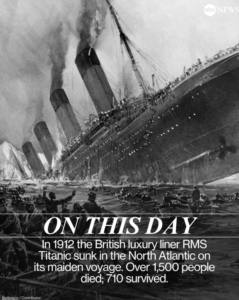Today in History: April 15 – The Titanic Sinks in the North Atlantic
In the early morning hours of April 15, 1912, the RMS Titanic, once hailed as the largest and most luxurious ship in the world, sank into the icy waters of the North Atlantic Ocean. The disaster, which resulted in the deaths of more than 1,500 people, remains one of the deadliest commercial peacetime maritime tragedies in modern history and continues to fascinate and haunt the public more than a century later.
The Titanic, operated by the White Star Line, embarked on its maiden voyage from Southampton, England, on April 10, 1912. Its destination was New York City. On board were over 2,200 passengers and crew, including some of the wealthiest people in the world, as well as hundreds of immigrants hoping for a new life in America. The ship was considered a marvel of engineering and was believed to be “practically unsinkable,” a claim tragically disproven just days later.
Shortly before midnight on April 14, the Titanic struck an iceberg in the North Atlantic. The collision opened a series of gashes below the waterline, compromising five of the ship’s supposedly watertight compartments. Although the crew initially believed the ship could stay afloat, it soon became evident that the Titanic was doomed. The lack of sufficient lifeboats—only enough for about half of those on board—meant that many would not survive.
Chaos unfolded as lifeboats were launched, many of them half-full, while passengers and crew scrambled for safety. Due to outdated maritime safety regulations, the ship carried only 20 lifeboats—enough for just 1,178 people. Women and children were prioritized, leaving many men behind, including Titanic’s captain, Edward J. Smith, and prominent figures such as John Jacob Astor IV and Isidor Straus, co-owner of Macy’s.
At approximately 2:20 a.m. on April 15, the Titanic broke in two and sank beneath the ocean surface, taking with it more than two-thirds of those aboard. Survivors clung to lifeboats and debris, exposed to freezing temperatures. The RMS Carpathia arrived around 4:00 a.m. to rescue the survivors, ultimately bringing just over 700 people to safety.
The sinking of the Titanic shocked the world and prompted immediate changes in maritime law. These included the requirement for ships to carry enough lifeboats for all passengers, conduct regular lifeboat drills, and maintain 24-hour radio watch. The tragedy also led to the establishment of the International Ice Patrol to monitor iceberg danger in the North Atlantic.
Today, April 15 stands as a somber reminder of human hubris, the fragility of life, and the importance of safety over luxury. The Titanic lives on through countless books, films, exhibitions, and explorations of its wreckage—now lying more than two miles beneath the surface. The stories of heroism, sacrifice, and loss continue to resonate, ensuring the memory of the Titanic endures for generations to come.
